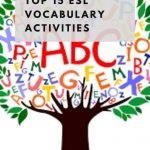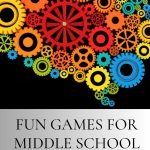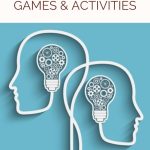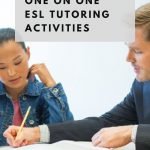If you teach English to kindergarten kids, you don’t need me to tell you that it can a little bit challenging. Seriously, I’ve been there and it was tough, really tough. However, I discovered that with some solid activities in my lesson plan, things went far more smoothly. That’s why I’m sharing my favourite English games for kindergartners. Try them out and I’m sure you’ll have a great time in your classes.
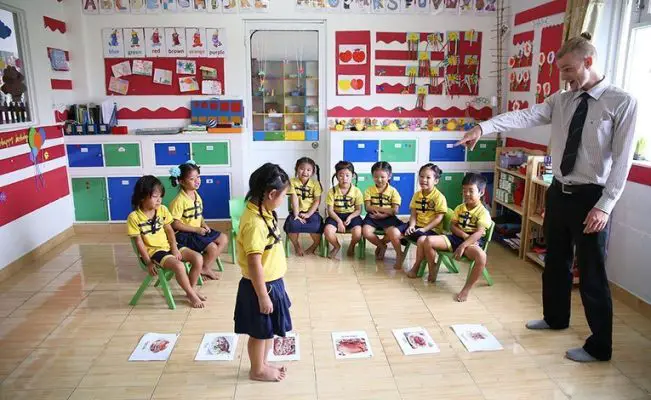
ESL activities and games for kindergarten kids
Need some help with ESL for toddlers? Look no further! Let’s get into the top ESL kindergarten activities and games to try out in your classes. Your students will love them!
Kindergarten ESL Activities and Games
Here are some of my top picks for ESL activities and games for Kindergarten Kids. The good news is that Hangman isn’t on the list. And the better news is that all of these activities have some sort of educational value! Happy students, happy teachers, and perhaps most importantly, happy parents.
#1: ESL Flashcard Games for Kindergarten
Most ESL textbooks for kids have an optional set of flashcards with all the vocabulary words that you can buy. At the most basic level, you can use them to teach colours. Whatever you do, try to get your hands on them. They’ll be some ESL teaching gold and you can do a million and one things with them.
To see what I do with flashcards and kindy kids, check out this article:
ESL flashcard games all the way! Trust me on this one. They’ll definitely make your life easier and if there’s one thing I don’t walk into a kindy class without, it’s a set of these things. Flashcards also make an ideal ESL preschool activity for even younger learners.
- Amazon Kindle Edition
- Bolen, Jackie (Author)
- English (Publication Language)
- 92 Pages - 07/12/2015 (Publication Date)
#2 ESL Games for Kindergarten: Concentration Matching Game
This is a challenging, but fun game that kindergarten kids love playing. You make cards that are in pairs. What can be on each card depends on the level of the student. However, with kindy kids, it may be quite simple pictures and words. For example, cat, dog, blue, red, etc.
Then, you place the cards facedown and the first student has to pick two cards. Turn them over, and if they’re a match, they get to keep them. If not, turn them over in the same spot and the next student goes.
This memory game is an excellent way to review vocabulary. Learn more about it here:
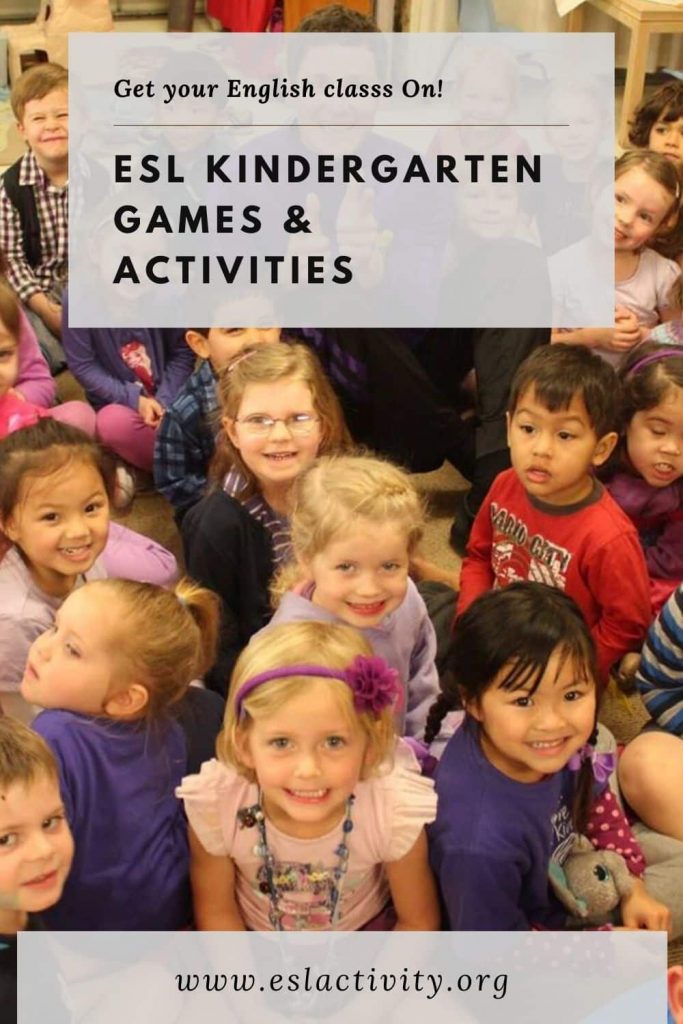
ESL kindergarten activities and games
#3 Warmup Activities for Kids: Videos in the ESL Classroom
There a ton of reasons why you might want to use videos in your ESL kindy classroom. Taking a break (for the teacher) isn’t really one of them. There are so many educational things you can do that it’d be crazy not to use them! Here are some ways that you can get the best value out of them:
- Amazon Kindle Edition
- Bolen, Jackie (Author)
- English (Publication Language)
- 81 Pages - 08/26/2021 (Publication Date)
#4 ESL Activities for Kindergarten: Picture Prompt
Kids love fun pictures (and adults too!). Kindy kids, of course are no exception. A single interesting picture put up on the PowerPoint can elicit a ton of language. It’s the ideal warmer activity so try it out with your kids today:
It’s certainly one of my favourite English games for kindergartners, preschool, and toddlers.
#5: ESL Speaking Bingo
What kid doesn’t love bingo, right? Adults seem to like it as well and it’s kind of a staple in most English classrooms. However, you can make it a bit more educational by including a speaking aspect with it. Instead of just saying the word, you describe it to your students.
It also turns it from strictly a vocabulary recognition activity into a bit more of listening one.
Find out more here about one of the most fun games for kindergarten class:
- Amazon Kindle Edition
- Bolen, Jackie (Author)
- English (Publication Language)
- 62 Pages - 01/21/2016 (Publication Date)
#6: Discussion Starters for Kindergarten Kids
If you teach more advanced, or slightly older kindy kids, you may want to try some of these discussion starters. They cover things like food, family (more ideas here: ESL Family Activities), school, etc.
Check them out here:
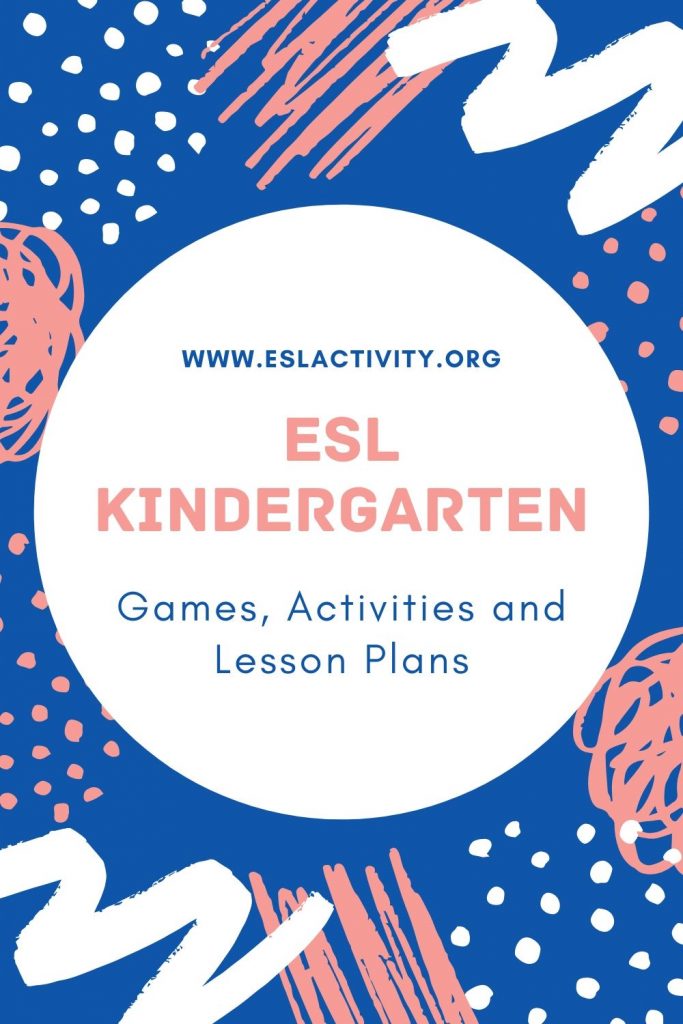
ESL games and activities for kindergarten
#7: Total Physical Response (TPR)
TPR, when done with kids usually involves things like:
- Touch your left leg!
- Touch something blue
- Life two hands into the air
This can be a fun warm-up activity and can bring some energy back into the classroom if you have sleepy students. Kids also never seem to get tired of this thing. It’s actually one of the best kindergarten listening activities out there so give it a try for yourself. And of course, let us know how it goes!
This is one of the best things you can do for ESL for toddlers and it’s one of the best ESL preschool activities.
#8: Mystery Box, a Fun ESL Kindy Game
If you want to have some serious fun with your ESL kindergarten students, then you’re going to need to make yourself a mystery box. It’s ideal for student who know some adjectives.
Find out more here:
#9 Kindergarten Icebreaker: Ball Toss
Like mystery box, ball toss is a super fun one that you can try out with your kindy kids. However, be warned that you should really only attempt it with smaller classes, and a beach ball with this age group. The way it works is that you write questions on the ball. Toss the ball to a student who has to answer a question that’s under their right thumb.
Want to check out one of my favourite ESL kindergarten games? Learn more here:
It’s also one of the best kindergarten get to know you games if you write the student’s names on the ball. Then, the name they touch, they have to throw the ball to.
#10: Odd One Out ESL Warm-Up
If your kindergarten kids know a decent amount of vocabulary, you can try odd one out. You can do this by speaking (and then it becomes a listening activity) or by writing, if they know how to read.
Say or write 4 things. For example: apple, banana, orange, chair.
Which one doesn’t belong? A chair. More advanced level students can say why (it’s not a fruit).
Learn more about this activity here:
- Amazon Kindle Edition
- Smith, Jennifer Booker (Author)
- English (Publication Language)
- 85 Pages - 12/24/2015 (Publication Date)
#11: ESL Yes and No Question Activities
The be verb in the present simple is often the first grammar that students learn when they’re learning English. It’s easy enough, but question forms can be a little bit tricky. If you want to have some fun with this, while helping your students perfect them, then you’ll need to check this out:
Yes or No Question Games for ESL.
#12: ESL Whiteboard Games
Students of any age LOVE to write on the whiteboard and kindy kids go crazy for it. There are a ton of fun whiteboard games and activities for ESL students that you can try out. Seriously, just try it out and your students will keep coming back for more!
Find out some of our top picks right here: ESL Whiteboard Games.
#13: Dialogue Substitution
#14: Number Games for Kindergarten Class
Teaching kindergarten kids number is always a win! It’s simple, easy to understand vocabulary and you can do a ton of stuff with it.
There are lots of fun games and activities you can do with numbers, math and counting. Check out some of my top picks here: ESL Number Games.
#14: Kindergarten ESL Activities for Food
Who doesn’t like food, right? It’s one of the most common topics in ESL/EFL textbooks, including ones for kindergarten kids. The best part about this unit is that there are so many things you can do with it. Here are some of my top picks: ESL Food Activities.
#15: Preposition of Place Games for Kindergarten Class
Prepositions are another one of those fun topics that lend themselves well to teaching young children. You can have lots of fun with things like in/on/between/next to, etc. Flashcards, whiteboard games, secret games, etc. all work well with this unit.
Do you want some ideas to get started? You’ll need to check this out then: ESL Preposition of Place Activities.
#16: Songs and Chants for Kindergarten ESL
I love to use songs and chants when teaching young children. One of my favourite things is when I catch my students singing some of these songs outside of the class! Even if you’re not musical (like me), it’s still possible to do this with the help of YouTube!
#17: English Vocabulary Quiz for Very Young Learners
#18: Mixed up Sentences
A fun way to review simple English grammar for ESL kindergarten is to mix up some sentences in terms of word order. Then, students have to unscramble the words to make good sentences. For example:
- goes he school to = He goes to school.
- Mom likes my pizza = My Mom likes pizza.
Find out more about is here: Mixed Up Sentences ESL Activity.
#19: ESL Halloween Games and Activities
What kid doesn’t love Halloween, right? I love to have some party days for major holidays in my home country of Canada. The good news is that there are a ton of fun and exciting things you can do in TEFL classes for this popular holiday. Here are some of the best ideas:
#20: ESL Clothing Activities
Clothing is one of the first things that young children learn when beginning with English. The vocabulary is something very familiar to young kids and the concept is also concrete enough for their developing brains. Check out some of my recommendations for this popular unit in ESL textbooks:
#21: Word Challenge
If your students know how to read and write basic words, then consider this whiteboard listening and spelling game. The way it works is that you say a word out loud and two (or three) students race to write the correct word on the board.
Want to give it a try with your students? You can check it out here: ESL Word Challenge.
#22: Me Too!
Try out this simple ESL activity that requires nothing in the way of preparation or materials. The way it works is that students take turns saying a fact about themselves that they think they’ll have in common with some, but not all of the other students.
Then the students that can agree say, “Me too!” Want to try it out with your young learners? Find out all the information here: Me Too!
#23: Is that Sentence Correct?
A simple way to test grammar knowledge for your kindy students who can read is to write some sentences on the board. Some are correct but others are not. For example:
- He are tall.
- She is tall.
Students have to tell you if a sentence is correct or not. If incorrect, they have to tell you what changes to make. Find out more here:
Sentence Correction ESL Activity.
#24: Hot Potato Game
#25: Chain Spelling Activity
If you’re teaching your students how to read then you may want to consider playing this spelling game. The way it works is that all the students stand up. Then, you say a word and students take turns spelling it out letter by letter. If someone doesn’t get the correct letter, they are “out.”
#26: More Ideas for Teaching Young Learners
#27: A to Z Review Game
Do you have kindergarten students that know how to read and write basics things in English? Then you’ll definitely want to try out the A-Z game or activity. For kids this young, I’d probably do it together as a class on the whiteboard. Or, if your students are a bit older, you can put them in groups of 2-3 and turn this into a game.
The way it works is that you choose a certain topic. Animals or jobs for example. Then, students have to come up with one of them that starts with each letter. For example:
A=Alligator
C=Cat
F=Fish
Etc. They try to get as many as possible in the allotted time, but I only allow one per letter. Do you want to try out one of the best ESL activities for kindergarten? Learn more here: A-Z ESL Game.
#28: Use an ESL Warm-Up
#29: ESL Feeling and Emotion Activities
It’s always worthwhile to teach kids how to express some basic emotions. Here are some of the best ideas for how to do that:
#30: Last Day of School Activities
There are a ton of fun things you can do with kindy kids on the last day. Have a look here for some of my favourite options:
What to do on the last day of school?
#31: All About Me Lesson Plan Ideas
Here are some fun ways for students to introduce themselves and get to know their classmates:
#32: Easy Animal Quiz for TEFL
#33: There Is There Are Activities
There is and there are: We use them all the time in English! They are a beginner concept that can get a wee bit tricky, even for higher-level learners. Here are some of my favourite options for giving students a lot of practice with them:
There is there are activities.
#34: Guessing Games for Kids
There are a number of fun things to do in class that involve guessing! Have a look here for some of my favourite ideas:
#35: Fill in the Blank Activities
A nice option for beginners is to use some fill-in-the-blank activities or worksheets. Here are some of the best recommendations:
#36: The Lineup Game
I love this simple activity because it requires nothing in the way of preparation or materials. It’s ideal if you have a few minutes at the end of class with nothing to do. Try it out:
#37: Shape Names in English
Learning the basic shapes is a nice option for very young learners. Check out this article for all the details:
Shape names in English with pictures.
#38: Animal Sounds in English
Kids love learning the noises that animals make in English. Here are some of the most common ones:
ESL Kindergarten Class FAQs
There are a number of common questions that people have about teaching ESL to kindy kids. Here are the answers to some of the most popular ones.
How do I Teach Kindergarten ESL?
Here are some of the top tips for teaching ESL to kindergarten students:
- Use hands-on activities that get students moving around the classroom
- Avoid talking and lecturing for long periods
- Use lots of interaction
- Review always
- Give gentle correction of errors
- Explore many different topics
- Use lots of praise
- Reinforce positive behaviour
How Do I Teach my 3-Year-Old English?
To teach a three year old English, here are a few tips:
- Short and simple is best (only 5-10 minutes)
- Introduce only a few new words at a time
- Use visuals
- Mix things up
- Repeat and review frequently
- Have realistic goals
- Use games
What Age is Best to Learn a Second Language?
Opinions vary but the general consensus is that the best age to learn a second language is before puberty. Some experts say the peak language acquisition stage happens around the age of 6 or 7, while others say that the window goes until puberty.
What is ESL?
ESL stands for English as a Second Language. It can be used to refer to ESL learners, or someone who is learning English. It can also refer to ESL teachers, or someone who is teaching English.
How can I teach ESL Kids New Words?
Kindergarten Get to Know You Activities
Here are some of my favourite get-to-know-you activities and games for very young learners.
Self-Portrait
Provide the children with paper and art supplies and ask them to draw a picture of themselves. This not only helps you get to know them but also provides an opportunity for self-expression.
All About Me Collage
Give the kids magazines, scissors, and glue. Ask them to cut out pictures of things they like and create a collage that represents themselves. They can then share their collages with the class.
“Me in a Bag” Show and Tell
Ask the students to bring a small item from home that’s important to them (e.g., a toy, a book, a photo). Have each child share their item with the class, explaining why it’s special.
Favorite Color Graph
Create a chart with different colors and ask the kids to place a sticker or draw a mark next to their favorite color. You can then count and discuss the results.
Feelings Chart
Introduce a feelings chart with different faces depicting various emotions. Discuss how they feel on the first day and encourage them to share their feelings with the group.
Family Photo Sharing
Ask the children to bring a family photo and briefly talk about their family. This helps create a sense of belonging and understanding among the kids.
Classroom Scavenger Hunt
Create a simple scavenger hunt with pictures or clues for the children to find things around the classroom. This activity helps them get familiar with their environment and classmates.
Tips for Teaching ESL to Very Young Learners
Teaching English as a Second Language (ESL) to very young learners can be a rewarding but challenging experience. Here are some tips to effectively teach ESL to young children
Use visuals and realia
Young children are highly visual learners. Utilize pictures, flashcards, props, and real objects to introduce and reinforce vocabulary. Visual aids help them make connections between words and their meanings.
Include movement and gestures
Young children have a lot of energy and benefit from activities that involve movement. Incorporate actions, gestures, and physical responses into your lessons to make them interactive and dynamic.
Provide a language-rich environment
Create an English-rich environment in the classroom by labeling objects, displaying vocabulary charts, and using English consistently during instruction. This helps children immerse themselves in the language and develop their listening and speaking skills.
Use games and hands-on activities
Young children learn best through play and hands-on activities. Integrate games, puzzles, crafts, and interactive tasks that encourage active participation and reinforce language concepts.
Keep instructions simple and clear
Use short, simple sentences when giving instructions to ensure understanding. Use gestures and visuals to support your instructions, especially if the children have limited English proficiency.
Repeat and reinforce
Young children need repetition to internalize language structures and vocabulary. Review previously learned material regularly and provide ample opportunities for practice through games, songs, and activities.
Encourage participation and interaction
Create a safe and supportive environment where children feel comfortable participating and expressing themselves in English. Use pair work, group activities, and role-plays to encourage interaction and communication.
Use storytelling and picture books
Storytelling and picture books capture children’s imagination and develop their listening and comprehension skills. Use age-appropriate stories and books with colorful illustrations to engage children in the language and promote vocabulary development.
Be patient, positive, and enthusiastic
Young learners thrive in a positive and encouraging atmosphere. Be patient with their progress, praise their efforts, and maintain a positive attitude. Your enthusiasm and genuine interest in their learning will motivate them to engage and enjoy the lessons.
ESL Kindergarten Lessons
If you want a ready-made ESL kindergarten lesson plan, then you should check out some of our favourite resources right here:
Or, just use some of the basic ESL textbooks for kids (New Parade for example) that usually have ready-made lessons that make it very easy to teach. This will usually be your best option if you teach very young learners.
Kindergarten English Worksheets
There are a number of excellent websites that can save a ton of time when lesson planning. Here are some of the best English kindy worksheets:
Did you Like these ESL Games for Kindergarten?
- Amazon Kindle Edition
- Smith, Jennifer Booker (Author)
- English (Publication Language)
- 144 Pages - 03/31/2016 (Publication Date)
Yes? Thought so. Then you’re going to love this book over on Amazon: 101 ESL Activities for Kids. It’s one of the best ESL resources for kindergarten. The key to better English classes for young learners is a wide variety of interesting, engaging, and student-centred games and activities. This book will help you get there in style.
You can find the book in a variety of formats. Keep a copy of the print book on the bookshelf in your office to use as a handy reference guide. Or, take the digital version with you to your favourite coffee shop for some serious lesson planning on the go. Finally, consider the audio version with you for some inspiration on your morning commute.
Whatever the case, get ready for some ESL teaching awesome in your life. You can find the best ESL resource for teaching kindergarten right here:
Have your say about ESL Kindergarten Activities
Do you have any tips or tricks for teaching ESL to kindy kids? Any games or activities that you love to use with your students, or have you tried one of them from this list? Please leave a comment below and let us know what you think. We’d love to hear from you.
Also be sure to give this article a share on Twitter, Facebook, or Pinterest. It’ll help other people like yourself find this useful resource.

ESL Activities for Kindy Students
Last update on 2022-07-17 / Affiliate links / Images from Amazon Product Advertising API







